By T. Ballard, J. Bousselot, S. Conrad, B. Gornick, C. Hayes, T. Hickey, R. Meyer, and M. Uchanski* (3/23)
Quick Facts…
- Agrivoltaics is the practice of producing both electricity and food on the same land
- Plants experienced less drought and heat stress when shaded by solar panel systems
- The shade produced by solar panels can also help reduce irrigation requirements
- Co-optimization challenges still exist between agricultural production and energy generation
- Broad adoption of solar development on agricultural lands will depend on local acceptance of new technology and positive economics
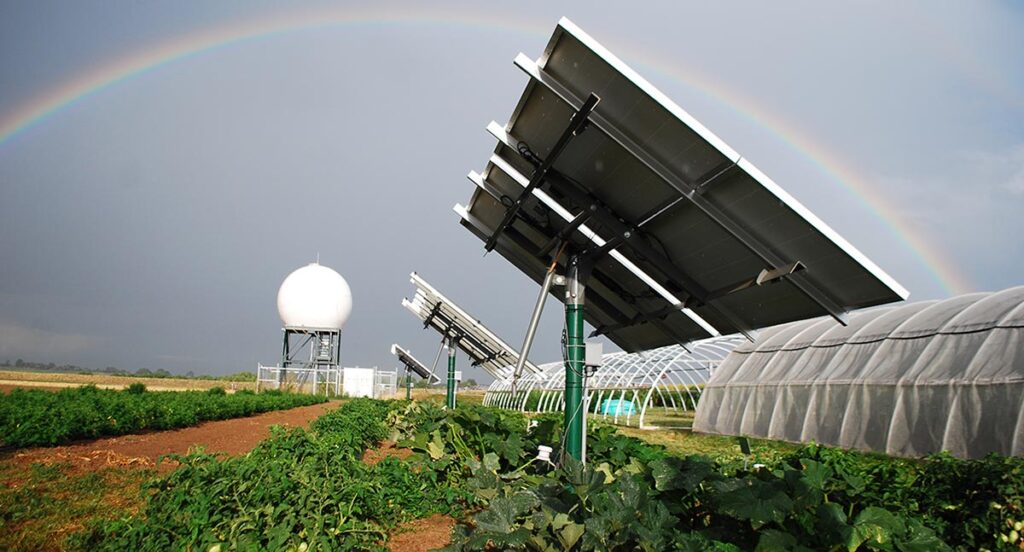
There is an ever-persistent demand for solar energy (photovoltaics or PV) installations concurring with increasing global populations demanding more energy and related issues surrounding climate change.
Agrivoltaics is the practice of producing both electricity (using solar panels) and food (agriculture) on the same land. This fact sheet provides a background on agrivoltaics, what we know from research, and some important considerations if you are considering agrivoltaics on your farm or property. Another CSU Extension resource, Photovoltaic System Feasibility Calculator can be used as a decision making tool.
Agrivoltaic installation options not only include areas of active crop production, but also livestock grazing land, pollinator habitat, commodity and fiber crops, urban rooftop farms (Figure 1), and “floatovoltaics” in aquaponic systems (Mow 2018; Pringle 2017). While not directly integrating both systems, low impact PV installations can be located adjacent to center pivot irrigated fields in dryland corners, or, on land that is not being utilized for other purposes (Mow 2018).
PV systems accounted for approximately 55% of renewable energy installations worldwide in 2019 (Agostini et al., 2021). As of 2021, small-scale solar PV energy generation in Colorado was at 95 gigawatt hours (GWh) or 95 million kilowatt hours (kWh), which contributes 2.5% of all small-scale PV generation in the US. In comparison, total PV generation in the US was at 88 terawatt hours (TWh) or 88 billion kWh, which equates to about 2.2% of the energy demand in the US (USEIA, 2021).
Agrivoltaic systems provide an option for reducing land competition between agriculture and renewable energy generation in an effort to meet current and future electricity demands (Adeh et al., 2019). Food, fuel, fiber, and energy markets typically compete for land use while agrivoltaics combines food and energy production systems at the same physical location (Barron-Gaffiord et al., 2019).
In some countries where cropland is limited (particularly in some US counties and states), there is a large potential for agricultural production and electric power generation to co-exist (Dupraz et al., 2011). Further utilizing land for agrivoltaics systems has the potential to increase farm productivity by 35-73% (Dupraz et al., 2011), although the best photovoltaic systems that will efficiently accommodate agricultural operations at various scales are still being investigated by researchers.
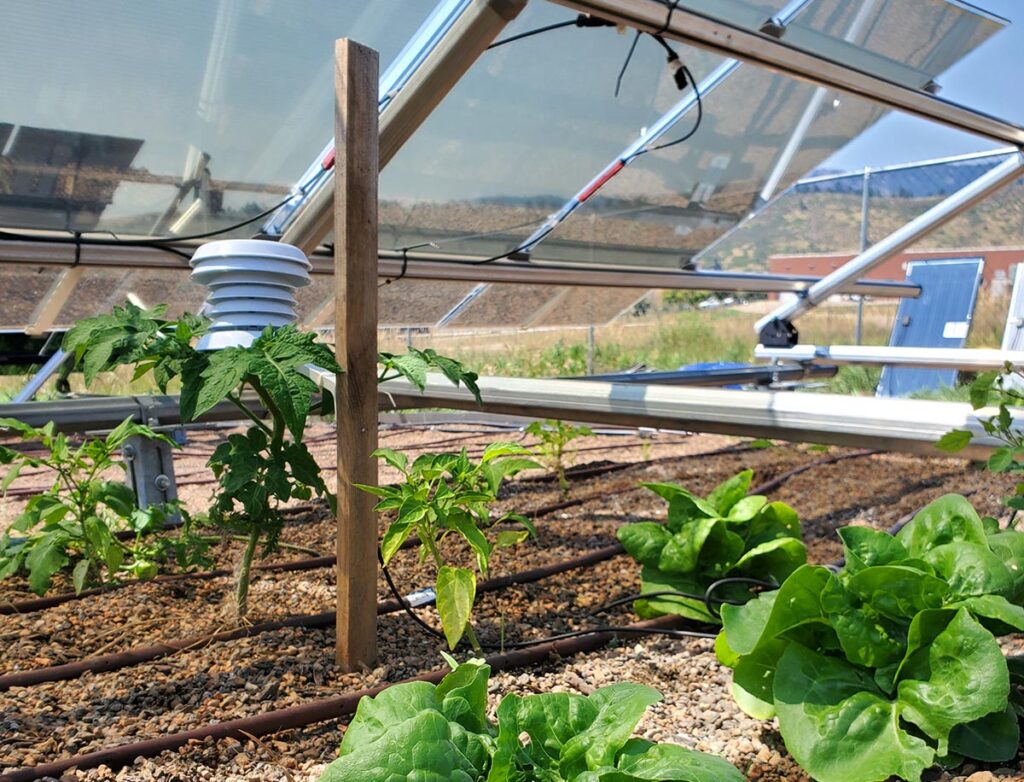
Overall Benefits of Agrivoltaics
Bringing PV systems to agricultural land can provide improved land efficiencies in both PV systems and agroecosystems relative to conventional PV systems. Research has found that plants experienced less drought stress and heat stress when shaded by PV systems in arid climates (Barron-Gafford et al., 2019). Evapotranspiration from soil and plants under the array creates a cooler microclimate that benefits PV energy output because reduced air temperatures around PV panels increases their overall power output efficiencies, especially in warmer months (Adeh et al., 2019).
In addition, research currently being done in Arizona by Barron-Gafford, et. al found higher nighttime and lower daytime air temperatures under PV panels when compared to traditional crop fields. In these systems, tomatoes showed improved photosynthesis and transpiration efficiencies in PV shade (BarronGafford et al., 2019). Shading may improve plant carbon dioxide uptake resulting in increased vegetative plant growth as plants grow larger to capture light (Barron-Gafford et al., 2019; Touil et al., 2021). In addition to crops, growing native plants below solar arrays can also benefit plant pollinator species (insects, and animals) resulting in cross benefits for the farm (Dunbar 2019).
The co-location of agriculture and energy production also has the potential to bring more reliable electricity to rural communities and directly offset on-farm energy consumption. Looking ahead, increased PV energy generation on farms and greenhouse operations will enable new opportunities for rural and agricultural communities. On-site PV can power rural micro-grids, energize electric farm equipment, aid in on-site nitrate (fertilizer) production, and integrate into greenhouse glazing to offset energy inputs for controlled environment agriculture.
The combined land use in agrivoltaic systems can greatly increase land use efficiencies while decreasing land use competition. The US Department of Energy’s 2021 Solar Future Study projects that we will install ground-based solar on ~10 million acres, or, 0.5% of Contiguous US land area by the year 2050 (DOE, 2021). To reach these metrics it is likely much of the added ground-based solar capacity will be installed on currently zoned agricultural lands. Agrivoltaics provides a solution to mitigate land-use conflicts by keeping lands agriculturally productive while producing renewable energy simultaneously on the same plot of land.
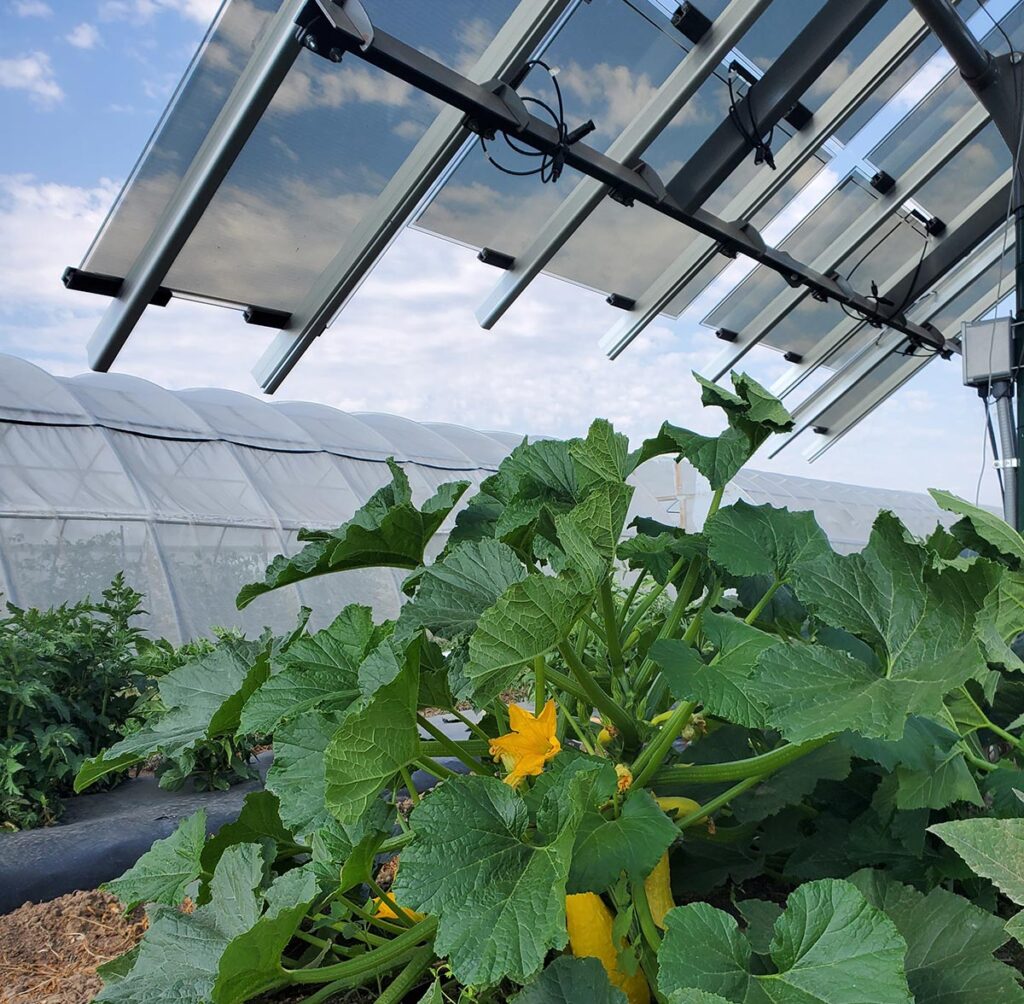
Crops and Agrivoltaics
Crops planted beneath solar panels receive protection from harsh weather such as hail or intense sunlight, helping crops to reach their production potential and saving some farms from unexpected crop loss (Trommsdorff et al., 2021).
Research has found that some crops are generally productive and have better overall health as a result from the unique microclimate present under PV systems (Touil et al., 2021). While some crops experienced reduced yield, other crops experienced no negative effect on productivity, and then some crops showed significantly improved performance from the shading effect of the PV system. Reported yield results from various garden plants are mixed under PV systems, but in one study tomato plants increased yield by 50% with higher shading (BarronGafford et al., 2019). The gain in yield is attributed in part to lower canopy temperatures, and higher soil moisture from the shade under the solar panels (Touil et al., 2021).
Overall, crop growth in agrivoltaic systems depends on many factors like regional climate (irradiance, precipitation, length of growing season, temperature) and PV array configuration (ex: height, row spacing, panel transparency, etc.), amongst others like soil type and growth habit. More research-validated crop modeling is needed to understand how crops and grasslands (Sturchio et al., 2022) respond to specific regions, irrigation, and PV configurations.
Water and Agrivoltaics
The shade produced by solar panels can also help reduce irrigation requirements (AL-agele et al., 2021). Drought stress is mitigated by shading under the solar panels as plants lose less water from evapotranspiration (Barron-Gafford et al., 2019; Elamri et al., 2018). Lettuce plants, for example, grown under solar panels were found to be productive, although lower in yield, with a 20% reduction in irrigation (Elamri et al., 2018). Water savings is particularly important in arid climates like Colorado with limited quantities of water available for irrigation.
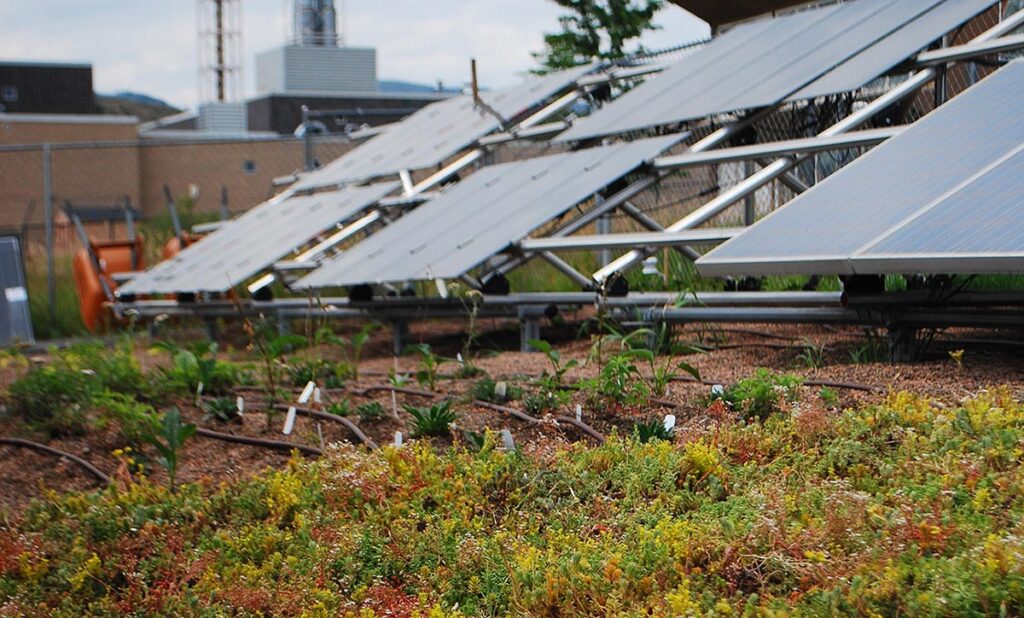
The Economics of Agrivoltaics
Research has suggested that the economic benefits to landowners adopting agrivoltaics are compelling. Overall, the economic factors such as electricity generation, water savings, crop production, and land value will be a determining factor in PV adaptability and compatibility with both agriculture and energy production systems being located together (Riaz et al., 2021; Touil et al., 2021). Some early research indicates that agrivoltaics systems provide increased revenue per acre in added income from electricity generation.
When land area is limited for solar array installations, as in Europe, agrivoltaics systems make the utilized space more economically viable (Agostini et al., 2021). Studies have found that farms containing agrivoltaic systems increase the lands’ sale value by over 30% (Majumdar and Pasqualetti, 2018; Ouzts 2017). Further economic benefits to agrivoltaics systems may exist, such as the use of grazing animals to harvest residue to reduce the costs (i.e. pesticides and labor) needed to maintain vegetation in those areas while also financially benefiting from the animals (Andrew et al., 2021). These potential benefits and trade-offs are currently under investigation in Colorado locations with high altitude and intense solar radiation.
Climate Benefits of Agrivoltaics
Implementing PV systems reduces non-renewable energy demands. Agrivoltaics has the potential to increase renewable energy generation, thereby decreasing carbon emissions and the impact of extreme weather events because of climate change (Adeh et al., 2019; Barron-Gafford et al., 2019). Worldwide, the production and use of energy accounts for 80% of carbon emissions. Coal power plants emit 756-1310 grams of CO2/kWh while PV power plants produce only 13-731 CO2/kWh (Shahsavari and Akbari, 2018). Extreme weather events also appear to be increasing in number and any decrease in non-renewable energy consumption could improve these conditions. When considering the vast agricultural footprint, if just 1% of cropland is converted to agrivoltaics systems, this could significantly offset global use of carbon-based energy sources (Adeh et al., 2019).
Agrivoltaic systems can also provide ecosystem services that are not realized with traditional PV systems. These systems maintain functionality of stormwater management, soil erosion prevention, and pollinator habitat (Ouzts 2017). Native pollinators benefit from established native flowering plants below solar panels, which can help reverse declining pollinator populations, especially in urban areas (Dunbar 2019).
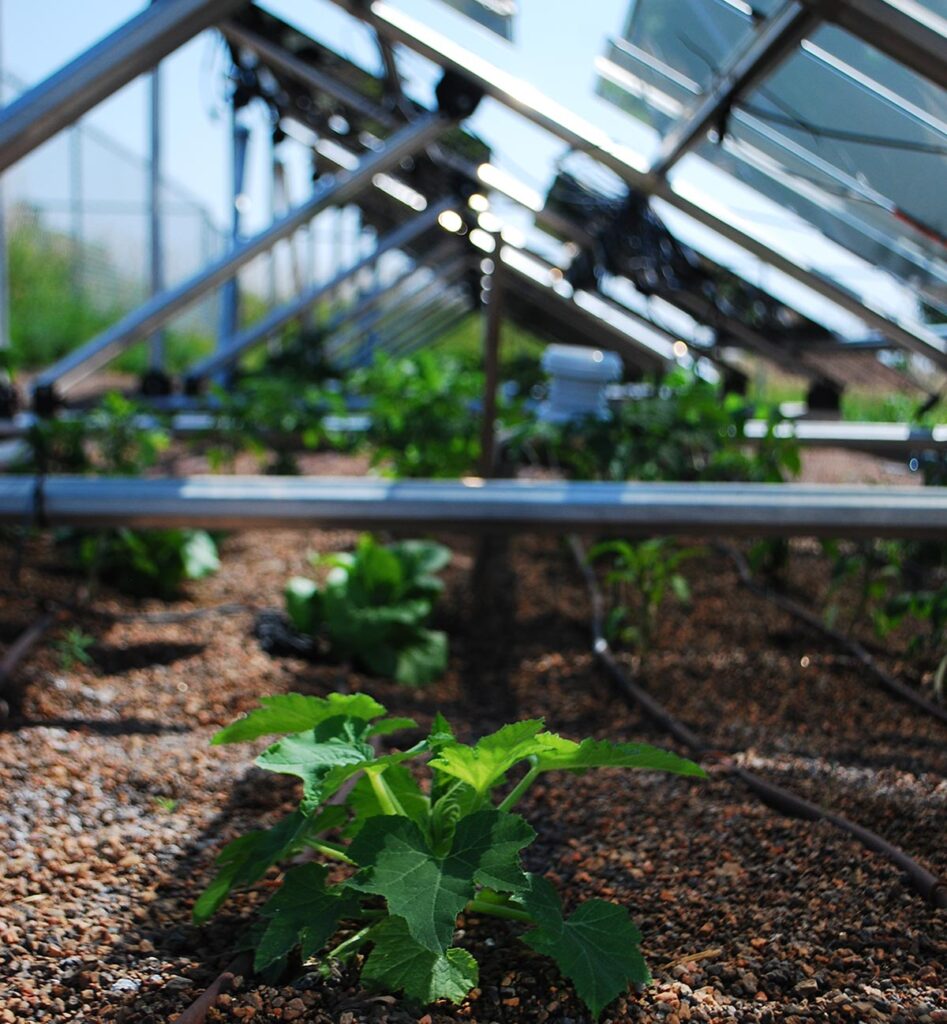
Future Challenges
Co-optimization challenges still exist between agricultural production and energy generation (Figure 1). Leading challenges include adjusting farming techniques to align with maximizing solar array orientation, incorporation of semi-transparent panels, and determining optimal coverage density (Majumdar and Pasqualetti, 2018; Riaz et al., 2021). Other challenges include planting and harvesting activities, along with crop choice, beneath solar panels.
Locating a solar farm can also be challenging as potential sites are positioned in rural spaces and may not be close enough to existing substation and transmission infrastructure to be viable. Previous geospatial research at CSU indicates that having a substation within 1 mile of these systems greatly affects PV installation feasibility.
Researchers in Colorado and a few other states are currently investigating agricultural cropping strategies to manage these issues along with additional concerns related to agrivoltaics.
One aspect currently being investigated includes avoiding and managing soil compaction resulting from PV installations. In addition, research is investigating how to best manage cropping strategies that involve equipment for both planting and harvesting operations. This challenge may include solar panels that are located higher above the crop canopy or solar panels that can rotate out of equipment’s paths during field operations.
Other crop strategies are simpler to manage such as grazing below the panels with sheep, cattle, or goats. Rooftop agriculture offers different challenges such as installation and maintenance of both the PV system and agricultural production on tops of buildings. However, rooftop agrivoltaics does not have the agricultural equipment issue as planting, maintaining, and harvesting is accomplished by hand labor. As with any green energy plan, upfront costs are high but corresponding returns from both energy production and food production can be positive over time. This return is dependent on the value received for both electricity generated and crop produced.
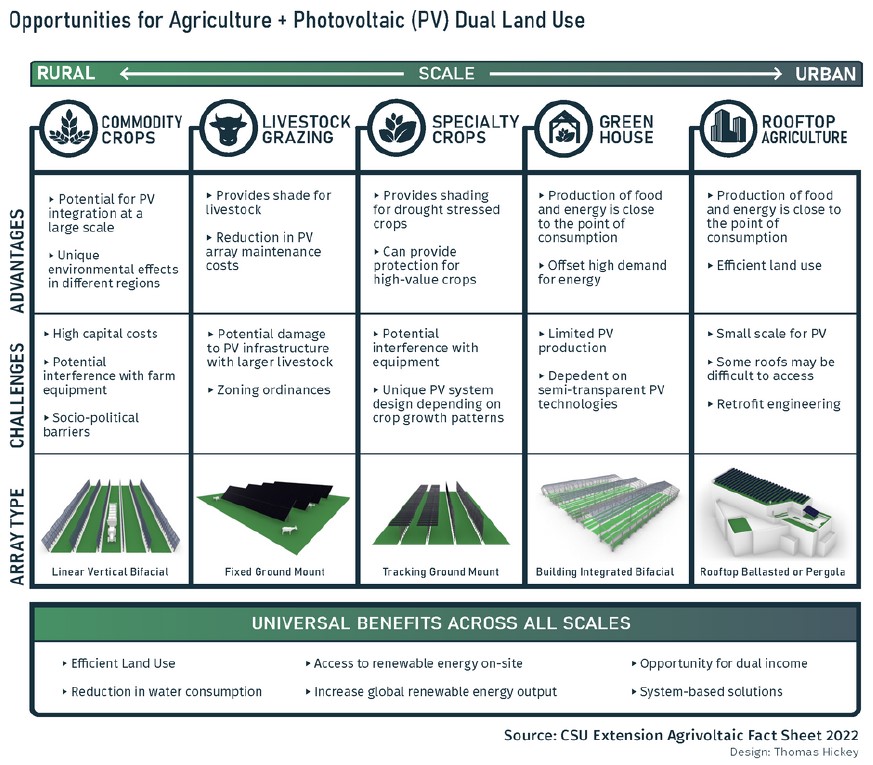
Figure 1: Agrivoltaic applications at multiple scales. Infographic designed by Thomas Hickey.
Broad adoption of solar development on agricultural lands will depend on local acceptance of new technology and positive economics, which relies on community level support, crop yields, and supportive local regulations (Pascaris et al., 2020), along with equipment and installation costs for PV systems.
To better understand agrivoltaic feasibility in your area, check with your appropriate local county advisory board, land commission and utility power company. Community engagement and outreach will be an essential component in achieving widespread implementation of this technology (Irie et al., 2019).
A multitude of diverse solutions will be needed to meet the renewable energy goals of the coming decades while protecting agricultural productivity and farm income. Agrivoltaics may provide environmentally and economically sustainable options for producers and landowners as we plan for a sustainable future.
Resources
Adeh, E.H., Good, S.P., Calaf, M. and Higgins, C.W. 2019. “Solar PV power potential is greatest over croplands.” Scientific Reports, 9(1). doi:10.1038/s41598-019-47803-3. Agostini, A., Colauzzi, M., and Amaducci, S. 2021. “Innovative agrivoltaic systems to produce sustainable energy: An economic and environmental assessment.” Applied Energy, 281, 116102.
AL-agele, H.A., Proctor, K., Murthy, G., and Higgins, C. 2021. “A case study of tomato (Solanum lycopersicon var. Legend) production and water productivity in agrivoltaic systems.” Sustainability, 13(5), 2850.
Andrew, A.C., Higgins, C.W., Smallman, M.A., Graham, M., and Ates, S. 2021. Herbage yield, lamb growth and foraging behavior in agrivoltaic production system. Frontiers in Sustainable Food Systems, 5, 126.
Barron-Gafford, G.A., Pavao-Zuckerman, M.A., Minor, R.L., Sutter, L.F., Barnett-Moreno, I., Blackett, D.T., Thompson, M., Dimond, K., Gerlak, A.K., Nabhan, G.P. and Macknick, J.E. 2019. “Agrivoltaics provide mutual benefits across the food– energy–water nexus in drylands.” Nature Sustainability, 2: 1- 8.
Dunbar, E. 2019. “Solar energy finds ways to help soil, pollinators.” MPR News. www.mprnews.org/story/2019/06/20/pollinatorfriendly-solarenergy-becomes-the-norm-in-minnesota.
Dupraz, C., Marrou, H., Talbot, G., Dufour, L., Nogier, A., and Ferard, Y. 2011. “Combining solar photovoltaic panels and food crops for optimising land use: Towards new agrivoltaic schemes.” Renewable energy, 36(10), 2725-2732.
Elamri, Y., Cheviron, B., Lopez, J.M., Dejean, C. and Belaud, G. 2018. “Water budget and crop modelling for agrivoltaic systems: Application to irrigated lettuces.” Agricultural Water Management, 208: 440-453
Irie, N., Kawahara, N. and Esteves, A.M. 2019. “Sector-wide social impact scoping of agrivoltaic systems: A case study in Japan.” Renewable Energy, 139: 1463-1476. doi:10.1016/j.renene.2019.02.048.
Majumdar, D. and Pasqualetti, M.J. 2018. “Dual use of agricultural land: Introducing ‘agrivoltaics’ in Phoenix Metropolitan Statistical Area, USA.” Landscape and Urban Planning, 170: 150-168.
Mow, B.. “Solar Sheep and Voltaic Veggies: Uniting Solar Power and Agriculture.” 2018. NREL.gov, www.nrel.gov/state-local-tribal/blog/posts/solar-sheep-andvoltaic-veggies-uniting-solar-power-and-agriculture.html.
Ouzts, E. 2017. “Farmers, experts: solar and agriculture ‘complementary, not competing’ in North Carolina.” Energy News Network, 24 Aug. energynews.us/2017/08/28/farmersexperts-solar-and-agriculture-complementary-notcompeting-in-north-carolina/.
Pascaris, A.S., Schelly, C. and Pearce, J.M. 2020. “A first investigation of agriculture sector perspectives on the opportunities and barriers for agrivoltaics.” Agronomy, 10(12): 1885. doi:10.3390/agronomy10121885. Pringle, A.M., Handler, R.M. and Pearce, J.M. 2017.
“Aquavoltaics: Synergies for dual use of water area for solar photovoltaic electricity generation and aquaculture.” Renewable and Sustainable Energy Reviews, 80: 572-584., doi:10.1016/j.rser.2017.05.191.
Riaz, M.H., Imran, H., Younas, R., Alam, M.A. and Butt, N.Z. 2021. “Module technology for agrivoltaics: Vertical bifacial versus tilted monofacial farms.” IEEE Journal of Photovoltaics, 11(2): 469-477. doi:10.1109/jphotov.2020.3048225.
Shahsavari, A., and Akbari, M. 2018. Potential of solar energy in developing countries for reducing energy-related emissions. Renewable and Sustainable Energy Reviews, 90, 275-291.
Sturchio, M.A., Macknick, J.E., Barron‐Gafford, G A., Chen, A., Alderfer, C., Condon, K., and Knapp, A.K. 2022. Grassland productivity responds unexpectedly to dynamic light and soil water environments induced by photovoltaic arrays. Ecosphere, 13(12), e4334.
Touil, S., Richa, A., Fizir, M. and Bingwa, B. 2021. “Shading effect of photovoltaic panels on horticulture crops production: A mini review.” Reviews in Environmental Science and Bio/Technology, 20(2): 281-296. doi:10.1007/s11157-021-09572-2.
Trommsdorff, M., Kang, J., Reise, C., Schindele, S., Bopp, G., Ehmann, A., Weselek, A., Högy, P., Obergfell, T. 2021. “Combining food and energy production: Design of an agrivoltaic system applied in arable and vegetable farming in Germany. Renewable and Sustainable Energy Reviews, 140, 110694.
US Department of Energy (DOE). 2021. Solar Futures Study. Energy.gov. https://www.energy.gov/eere/solar/solarfutures-study.
United States Energy Information Administration (USEIA). 2021. “Colorado State Energy Profile.” https://www.eia.gov/state/print.php?sid=CO.
Colorado State University, U.S. Department of Agriculture and Colorado counties cooperating. CSU Extension programs are available to all without discrimination. No endorsement of products mentioned is intended nor is criticism implied of products not mentioned.





